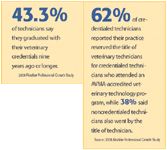The truth about the veterinary technician shortage
Will low salaries and high turnover threaten this career?
The Bureau of Labor Statistics (BLS) ranks veterinary technology as one of the fastest growing careers. In fact, it estimates a 41 percent growth by 2016. Yet AAHA's newly released Compensation and Benefits, Fifth Edition, indicates turnover may take a bite out of the profession. Their research shows turnover is almost 30 percent in veterinary practices, compared to a national average of between 12 percent and 15 percent across all industries in the United States. And when they focused on technicians, the rate of turnover climbs to 35 percent.

About 83 percent of NAVTA members say they'll probably or definitely stay in the profession, according to the 2007 NAVTA National Demographic Survey. And about 15 percent report they'll probably or definitely change to another field. This mirrors the results from the 2008 Firstline Professional Growth Study (see Figure 1). Yet 79 percent of NAVTA members and 85 percent of nonmembers agree or strongly agree that veterinary technicians are so underpaid that the feasibility of staying in the profession is declining (see Figure 3).

Will technicians stay?
For those who plan to leave, where do they plan to go? See Figure 2 to learn more about technicians' intentions.

Where will they work?
As the BLS notes, it may be difficult to make up the difference with new graduates. A look at the numbers of technician candidates taking the Veterinary Technician National Exam shows growth is flat. The American Association of Veterinary State Boards, the organization that administers the test, reports 5,425 candidates in 2006 and 4,664 in 2007. 2008 estimates put the number of candidates at 5,200.
So what does this all mean? "We've got some great jobs, but we've got to step it up," says Firstline Editorial Advisory Board member Sheila Grosdidier, BS, RVT, a partner at VMC Inc. in Evergreen, Colo. "We're not just competing with other veterinary clinics for good personnel. We're competing with all other industries for good personnel."

Technician salaries
